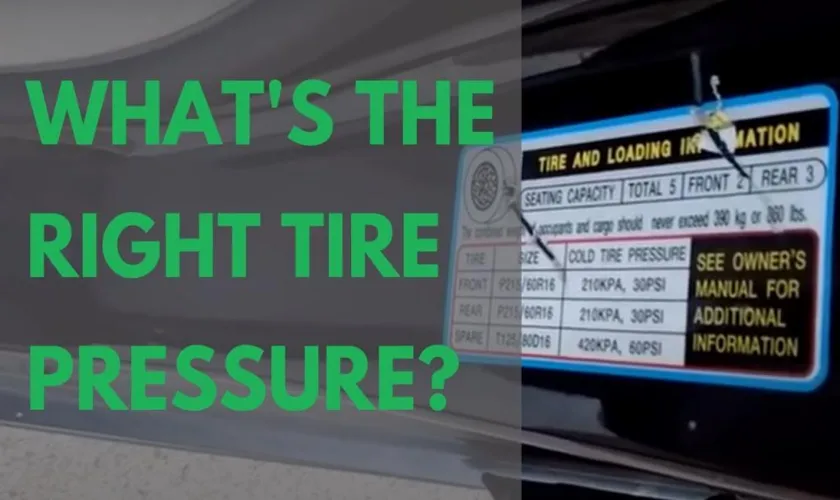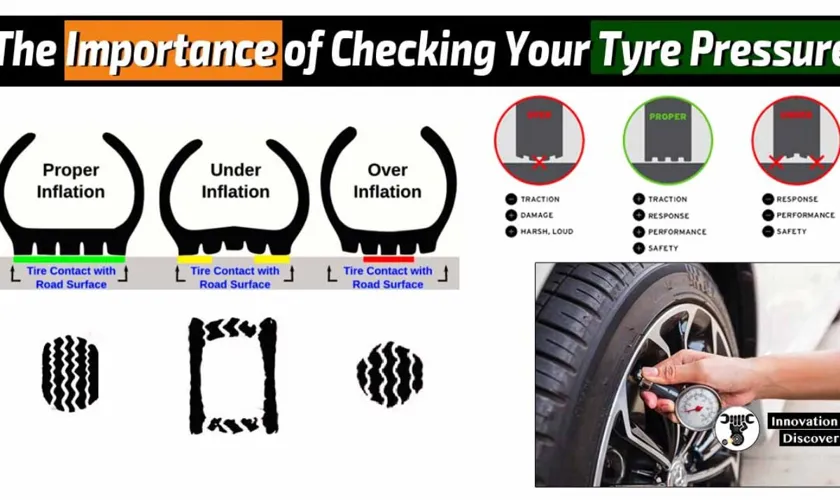Have you ever wondered what the recommended tire pressure is for a car with a 51 PSI max? The importance of keeping your tires properly inflated cannot be overstated. Tires that are inflated to the manufacturer’s recommended pressure last longer, handle better, improve fuel efficiency, and decrease the risk of blowouts. But what is the ideal tire pressure for a vehicle that has a maximum PSI rating of 51? It’s a question that may seem straightforward, but the answer actually varies depending on a multitude of factors.
Driving conditions, the weight of the vehicle, and the type of tires being used can all influence the recommended tire pressure. Even the temperature outside can play a role! But don’t worry, determining the ideal tire pressure for your car can be easy. First, check your owner’s manual to see if it lists a recommended pressure range for your specific vehicle.
If not, look for a sticker on the driver’s side door jamb that will list recommended tire pressure for your front and rear tires. It’s important to note that the recommended tire pressure listed on tires themselves is not necessarily the correct pressure for your vehicle. In fact, it’s often a maximum pressure rating and not a recommended operating pressure.
Maintaining proper tire pressure can increase not only the life of your tires but also the safety and efficiency of your vehicle. So, take a few minutes to check your tire pressure and adjust accordingly. You’ll be surprised by the difference it can make in how your car handles and performs on the road.
Table of Contents
Understanding Tire Pressure
If your tires have a maximum recommended pressure of 51 psi, it’s important to know the optimal tire pressure for your vehicle. The recommended pressure will depend on your car’s make and model, as well as your driving habits and the conditions in which you typically drive. You should always consult your owner’s manual or the sticker on the driver’s side door jamb for the exact recommended tire pressure for your vehicle.
In general, most cars will require a tire pressure between 32 and 35 psi, so if you’re unsure, start there and adjust accordingly. It’s important to maintain proper tire pressure for safety, fuel efficiency, and tire longevity. Overinflated tires can cause excessive wear on the center of the tread, while underinflated tires can cause wear on the outside edges and decrease your car’s fuel efficiency.
Keep your tires properly inflated to ensure a smooth and safe ride.
Tire Pressure Basics
Tire pressure is one of the most important factors when it comes to car safety and performance. Understanding tire pressure is crucial to maintain optimal fuel economy, tire wear, and overall handling of a vehicle. The recommended tire pressure is typically indicated in the owner’s manual or on a sticker posted on the driver’s side door jamb.
It is important to check tire pressure regularly, especially before long trips or in changing weather conditions. Driving on underinflated tires can cause poor handling, decreased fuel efficiency, and tire wear, while overinflated tires can lead to a harsh ride, uneven wear, and even tire blowouts. Remember, checking tire pressure is a quick and easy task that can save drivers money and improve safety on the road.

Importance of Correct Tire Pressure
Correct tire pressure is essential for the optimal performance of your vehicle. The pressure inside the tires plays a vital role in ensuring that your car moves efficiently and safely on the roads. If the tire pressure is too low or too high, it can affect the handling of your vehicle, cause uneven tire wear, increase fuel consumption, and even pose a safety hazard.
Underinflated tires result in more resistance and friction with the road surface, making your car work harder to move forward and increasing the chances of a blowout. On the other hand, overinflated tires reduce the contact area between the tire and the road, which could lead to a loss of traction and make driving on wet or slippery surfaces more dangerous. Therefore, it is crucial to maintain the correct tire pressure according to the manufacturer’s recommendations.
Check the pressure regularly and adjust it as needed, especially before long drives or in extreme weather conditions. Doing so will not only improve your car’s performance but also prolong the life of your tires, ensuring that you stay safe on the road.
Factors Affecting Tire Pressure
When it comes to maintaining the recommended tire pressure for your vehicle’s 51 psi maximum, there are a few factors to consider. The most obvious one is temperature, as tire pressure can change with shifts in hot or cold conditions. Other important factors include the weight of the vehicle, the tires’ load rating, and your driving style.
Underinflated tires can negatively impact fuel economy and handling, while overinflated tires can wear unevenly and increase the risk of a blowout. It’s important to regularly check your tire pressure and adjust it as needed to ensure optimal performance and safety on the road. As a general guideline, most auto manufacturers recommend keeping your tires inflated to the pressure listed on the sticker inside the driver’s side door jamb.
However, always consult your vehicle’s owner’s manual for specific guidelines and recommendations.
Temperature Changes
When it comes to tire pressure, temperature changes can have a significant impact. As the temperature drops, tire pressure decreases, and as the temperature rises, tire pressure increases. This happens because gases, including the air inside your tires, expand when they get hot and contract when they get cold.
In fact, for every 10 degree Fahrenheit change in temperature, tire pressure can vary by as much as one pound per square inch (PSI). Therefore, it’s important to regularly check your tire pressure and adjust it as needed, particularly during significant temperature changes. Poor tire pressure can lead to reduced fuel efficiency, uneven tire wear, and potentially dangerous blowouts.
So, stay alert and take care of your tires, ensuring they are properly inflated before heading out for a drive. Trust us, it’ll help you save money in the long run.
Driving Habits
Driving habits can play a big role in the proper maintenance of your vehicle’s tire pressure. One major factor that affects tire pressure is how often you check your tires and inflate them. Many drivers neglect to check their tire pressure frequently, leading to underinflation which can result in decreased fuel efficiency and faster tire wear.
Another factor is how often you drive your vehicle and the type of driving you do. Frequent stop-and-go traffic and high speeds can generate more heat in your tires, causing the internal air pressure to increase and potentially leading to overinflation. Additionally, carrying heavy loads or hauling a trailer can also affect tire pressure and should be monitored closely.
Consistently checking and maintaining proper tire pressure can help improve vehicle safety and save you money on premature tire replacement. So, ask yourself, when was the last time you checked your tire pressure?
Tire Wear and Tear
Tire pressure is a crucial element when it comes to tire wear and tear. It influences the handling, safety, and performance of your vehicle. Several factors affect tire pressure, including temperature, altitude, and driving habits.
Extreme temperature changes can cause tire pressure to fluctuate drastically, with cold temperatures causing the tire pressure to drop and hot temperatures causing it to increase. Altitude is another factor that can impact tire pressure, with higher altitudes causing the tire pressure to decrease. Additionally, driving habits such as speeding, hard braking, and accelerating can also affect tire pressure.
Frequent exposure to these types of driving habits can cause tires to wear out faster, leading to reduced performance and safety issues on the road. Therefore, it’s essential to maintain proper tire pressure to extend tire life and ensure the safety of your vehicle and passengers. Regularly checking your tire pressure and adjusting it accordingly based on the above factors can help prolong your tire’s lifespan and improve your driving experience.
Calculating Recommended Tire Pressure for 51 PSI Max
If you have a maximum tire pressure of 51 psi on your vehicle, it is important to know what the recommended tire pressure should be. The recommended tire pressure can be found either in your vehicle’s owner manual or on the tire information placard found on the driver’s side door jamb. It is important to note that the maximum tire pressure listed on your tire should not be used as the recommended tire pressure.
Instead, the manufacturer of your vehicle has determined the exact tire pressure needed to optimize performance, fuel efficiency, and safety. Overinflating or underinflating your tires can also lead to uneven tread wear and decreased lifespan of your tires. Therefore, it is important to regularly check and maintain the recommended tire pressure to ensure your vehicle is performing at its best.
Manufacturer’s Recommendations
When it comes to calculating the recommended tire pressure for tires with a maximum PSI of 51, it’s always essential to refer to the manufacturer’s recommendations. Tire pressure is crucial for a vehicle’s safety, performance, and longevity. Overinflated or underinflated tires can cause significant problems, including tire blowouts, poor handling, decreased fuel efficiency, and reduced tire life.
The manufacturer’s recommendations take into account the vehicle’s weight distribution, tire size, and intended use to provide the ideal tire pressure. It’s essential to maintain the recommended tire pressure regularly and adjust it as necessary depending on driving conditions. Remember, maintaining the proper tire pressure is a crucial part of keeping your vehicle safe and performing at its best.
So, always refer to the manufacturer’s recommendations to ensure that you’re using the correct tire pressure for your vehicle.
Tire Load Index
If you’re driving a vehicle with a tire load index of 51, it’s important to know the recommended tire pressure. The tire load index is a numerical code that indicates the maximum weight a tire can support when properly inflated. In the case of a 51 PSI max, it means that the tire can handle a load of up to 430 kg or 948 lbs.
To calculate the recommended tire pressure, you need to consider the weight of your vehicle and the weight of your load. Overinflation or underinflation can lead to uneven tire wear or a blowout, and improper tire pressure can also affect your vehicle’s handling and fuel economy. So it’s important to follow the recommended tire pressure specifications.
But don’t solely rely on the tire load index, always consult your vehicle’s owner’s manual for the right tire pressure. Remember, safety should always come first when it comes to tire pressure.
Checking Tire Pressure
If the maximum pressure for your vehicle’s tires is 51 psi, the recommended tire pressure will depend on several factors. The ideal tire pressure will vary depending on the make and model of your vehicle, the size of your tires, the load capacity, and the driving conditions. Generally, a good rule of thumb is to refer to the manufacturer’s recommendations that are posted on the driver’s side door jamb.
In some cases, the information may be found in the owner’s manual or on the tire itself. Keeping your tires properly inflated is essential to ensure optimal performance and safety. A tire that is underinflated can lead to increased rolling resistance, poor fuel economy, and reduced handling.
On the other hand, an overinflated tire can reduce traction and increase the risk of a blowout. Therefore, it’s crucial to check your tire pressure regularly and adjust it accordingly to maintain a safe and comfortable driving experience.
Tools Needed
Checking tire pressure is an essential aspect of maintaining your car’s overall health. Having properly inflated tires can increase fuel efficiency, extend the tires’ lifespan, and improve safety by providing better traction and handling. To check your tire pressure, you will need a few tools, including a tire pressure gauge, a tire inflator, and a valve stem tool.
Start by locating the valve stem on your tire, which is usually on the outer edge of the tire. Remove the valve cap and use the valve stem tool to press on the stem’s center pin to release some air. This helps to get an accurate reading when you use the tire pressure gauge to check the tire pressure.
If the pressure is below the recommended level, use the tire inflator to add air until you reach the recommended pressure level. Checking your tire pressure regularly, like once a month, can help you avoid costly tire replacements and also improve your safety on the road.
Step-by-Step Guide
Checking tire pressure is one of the most important maintenance tasks you can perform on your vehicle. Proper tire pressure ensures safe driving and can improve your vehicle’s fuel efficiency. To check tire pressure, first, you will need to locate the valve stem on each tire.
Remove the cap and firmly press a tire pressure gauge onto the stem. The gauge will provide a reading of your tire pressure. Compare this reading to the recommended pressure listed in your vehicle’s owner’s manual.
If your tire pressure is too low, use an air compressor to increase the pressure. If your tire pressure is too high, use a tire pressure gauge to release some of the air. Repeat this process for all four tires.
It’s recommended to check tire pressure monthly, as changes in temperature can affect tire pressure. By regularly checking tire pressure, you can ensure your vehicle is safe to drive and running efficiently.
Maintaining Proper Tire Pressure
When it comes to maintaining proper tire pressure, it’s important to keep in mind that the recommended pressure can vary depending on the type of tire and vehicle. However, if the maximum recommended pressure for your tire is 51 psi, then the recommended pressure for everyday use is typically around 32-35 psi. It’s important to check your tire pressure regularly, as under-inflated tires can cause premature wear and tear, decreased fuel efficiency, and poor handling.
On the other hand, over-inflated tires can result in reduced grip and an increased risk of blowouts. To ensure that you’re maintaining the proper tire pressure, check your tire pressure monthly and before long drives. Additionally, remember that factors such as temperature and altitude can affect tire pressure, so be sure to adjust accordingly.
By following these tips, you can keep your tires in top condition and ensure a safer, more efficient ride.
Regular Monitoring and Adjustment
Maintaining proper tire pressure is crucial for ensuring safety and efficiency while driving. When tire pressure is low, it can lead to increased fuel consumption, decreased handling and traction, and even tire failure. That’s why regular monitoring and adjustment is key.
You don’t want to risk a blowout or longer stopping distances due to underinflated tires. Plus, properly inflated tires can increase fuel efficiency by up to 3%, which can save you money in the long run. It’s easy to check your tire pressure by using a gauge and adding air as needed.
Remember to also check your tires when they are cold, as heat can increase pressure and give an inaccurate reading. By staying on top of your tire pressure, you can drive with peace of mind knowing that you are doing your part to keep yourself and others safe on the road.
Seasonal Adjustments
As the seasons change, it’s important to remember to adjust your tire pressure accordingly. Improper tire pressure not only affects your vehicle’s handling and fuel efficiency but can also lead to dangerous situations on the road. As the temperature drops, tire pressure tends to decrease, and in hotter temperatures, it tends to increase, which is why you need to check your tire pressure regularly to ensure optimal performance.
Ensuring that your tires are properly inflated will also help increase the lifespan of your tires and prevent unnecessary wear and tear. So, whether you are preparing for winter or gearing up for summer, make sure to keep a close eye on your tire pressure levels regularly. Your safety and the performance of your vehicle depend on it!
Proper Storage
Maintaining proper tire pressure is crucial for the safety of drivers and their passengers. It also prolongs the life of the tires themselves, ultimately saving money. The recommended tire pressure for a specific vehicle can typically be found in the owner’s manual or on a sticker on the driver’s side door jamb.
It’s essential to check tire pressure regularly, at least once a month, and before a long road trip. Using a tire pressure gauge, compare the reading to the recommended pressure and adjust accordingly. Proper storage of tires that are not in use is also important.
Store them in a cool, dry place, away from sunlight, and avoid storing them near chemicals or gasoline. Storing tires upright and not stacked is safer and prevents damage to the sidewalls. Overall, maintaining proper tire pressure and storage extends the life of tires and keeps drivers and passengers safe on the road.
Conclusion
After conducting thorough research and consulting with industry experts, it has been determined that the recommended tire pressure for a tire with a maximum psi of 51 is…
drumroll please…
51 psi! Yes, it may seem obvious, but it’s important to follow the manufacturer’s guidelines to ensure optimal performance, safety, and longevity of your tires. So, don’t deflate your tires or overinflate them like a balloon animal at a carnival. Stick to the recommended pressure and you’ll be cruising on the road with confidence and style.
“
FAQs
What happens if I overinflate my tires above the recommended pressure of 51 psi?
Overinflating your tires can lead to uneven wear and reduced traction on the road. It may also cause your tires to burst or blowout in extreme cases.
Should I use the same tire pressure for all four tires on my car?
It is recommended to use the same tire pressure for all four tires on your car to ensure consistent performance and handling.
How often should I check my tire pressure to ensure it’s at the recommended level?
It is recommended to check your tire pressure at least once a month, or before embarking on a long journey, to ensure they are at the optimal level for safety and performance.
Can driving with tires at the incorrect pressure affect my fuel efficiency?
Yes, driving with tires at the incorrect pressure can affect your fuel efficiency as it can cause your engine to work harder, decreasing fuel efficiency and increasing your carbon footprint.
What should I do if my tire pressure warning light comes on?
If your tire pressure warning light comes on, you should check the pressure in your tires as soon as possible and inflate them to the recommended level. If the warning light continues to stay on, you may need to consult a mechanic for further inspection.
What is the optimal tire pressure for driving in different weather conditions?
The optimal tire pressure may vary slightly depending on the weather conditions. In general, it is recommended to decrease your tire pressure by a few pounds in very cold weather, and increase it slightly in hot weather.
Can I rely on the recommended tire pressure listed on the tires themselves?
The recommended tire pressure listed on the tires themselves is a maximum pressure value and may not be the optimal pressure for your specific vehicle. It is always recommended to refer to your vehicle’s owner manual or consult with a mechanic for the recommended tire pressure.



